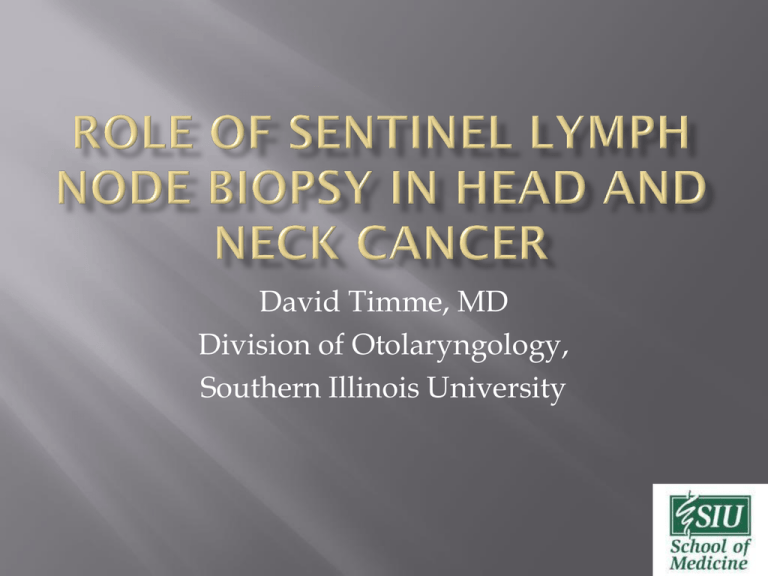
David Timme, MD
Division of Otolaryngology,
Southern Illinois University
Case Presentation
Lymphatic Drainage
History of neck dissection
Techniques of Sentinel Node Biopsy
Limitations
Histologic Evaluation
Role in Head/Neck Cancer
Directions for the Future
53 yo male with history of oral tongue cancer
Treated R partial glossectomy, b/l selective
neck dissections (1-3)
Recurrence of tumor at primary site
Radiographic, clinical N0 neck
HANOT recommendation for wide local
excision of site of recurrence
How to address elective neck dissection in
previously dissected neck
Case Presentation
Lymphatic Drainage
History of neck dissection
Techniques of Sentinel Node Biopsy
Limitations
Histologic Evaluation
Role in Head/Neck Cancer
Directions for the Future
1622 Aselli observed draining lymphatics in
dogs
1787 Cruikshank “The Anatomy of the
Absorbing Vessels of the Human Body”
1932 Rouviere classification of cervical lymph
nodes according to location
Memorial New York – described 7 levels
Nodal basins at risk according to location 4
Oral cavity/Oropharynx I-III
Laryngeal/Hypopharyngeal II-IV
Posterior scalp/suboccipital II-V
Thyroid II-IV, VI
Common patterns reflected
in NCCN clinical guidelines
More than one primary drainage location may
be present
Head and neck melanoma has more primary
nodal sites than other organ sites 6
Superficial Drainage Patterns (Cadaveric
Study) 7
Typically follow venous routes
Alternate patterns from one side to another
Lymphaticovenous shunt present
Anterior neck lymphatics
above platysma, upward to
mandible
Certain tumors may have skip metastases
First drainage node may differ from expected
location
Tumor size can alter lymphatic drainage
Previous resection, lymphadenectomy, or
radiation can all cause changes in drainage
patterns
Current standard of care is based upon
probabilities
“First draining lymph node to receive lymphatic
drainage from a primary tumor of a specific site”
Concept that a tumor will have preferred nodal
drainage basin, with a primary node
Seaman/Powers 1955 first echelon node, nodal
basin with radioactive colloid gold
Gould 1960 labeled first-echelon node the “sentinel
node”
Cabanas 1977 identified specific groin node in
primary penile cancer
Morton 1992 demonstrated intraoperative
mapping in humans with melanoma using dye
Ideal
Nodal Basin
Model:9
Tumor
Sentinel
Node
Reality:
Sentinel
Node?
Sentinel
Node?
Tumor
Sentinel
Node?
Sentinel
Node?
Reality:
UNPREDICTABLE
Sentinel
Node?
Sentinel
Node?
Tumor
Sentinel
Node?
Sentinel
Node?
Analogy:
UNPREDICTABLE
Case Presentation
Lymphatic Drainage
History of neck dissection
Techniques of Sentinel Node Biopsy
Limitations
Histologic Evaluation
Role in Head/Neck Cancer
Directions for the Future
19th Century occasional resection of grossly
involved lymph nodes
1885 Butlin – elective removal of nodes in
tongue cancer
1900 MacKenzie “extirpation of larynx with
..lymphatics and glands… diseased or not”
1888 Jawdynski described radical en bloc neck
dissection
1905 Crile 121 operations with illustrations of
block resections of cervical lymph nodes
Introduction of radical neck dissection
Hayes Martin 1951 – removal of CN XI, IJ, SCM
should be standard
Functional, or “modified radical neck
dissection” emerged in the 1950s
1960 Ballantyne pioneered modified approach
Continued work to determine optimal level of
appropriate dissection needed
Need to remove gross
disease
Prophylaxis against
future development of
metastases
Improve clinical
outcomes
Lessen undue
morbidity
shoulder dysfunction,
facial edema, carotid
blowout
Improve Clinical
Outcomes
Potentially lessen morbidity of large surgical
resection
Guide treatment approaches (further neck
dissection, radiation therapy, etc)
Further research of drainage patterns
Prognosis
Detect earlier stage “micrometastases”
High density of lymph nodes
Close proximity to primary tumor
Complex lymphatic pathways
Optimization of localization and imaging
essential for success
Case Presentation
Lymphatic Drainage
History of neck dissection
Techniques of Sentinel Node Biopsy
Limitations
Histologic Evaluation
Role in Head/Neck Cancer
Directions for the Future
Dye
Pre-operative dynamic scintigraphy
Planar imaging
SPECT/CT
Intraoperative static scintigraphy
Injection of Isosulfan blue dye submucously
around tumor
Nodes stained blue in 15-45 min after injection
Exposure of nodal basin
Removal of stained node
Invasiveness of broad exposure
Dye spillage around tumor – obscure margins
0.7-2% risk anaphylaxis
Skin tattooing
Washout with delay
Bredell reported on indocyanin green
fluorescence10
Similar limitations as with blue dye
Is Dye Necessary?
Clinical Guidelines suggest use of dye may be optional
Some advocate for triple technique
Shoaib – more nodes identified with
scintigraphy/dye combo compared to blue dye25
5/13 with dye
12/13 with radioactive tracer
Shoaib – 2 tumor positive nodes identified with
blue dye alone in series of 40 patients (combo
approach)26
Scintigraphy relies upon radioactive tracer
Ideal particle size 5-10nm – smaller particles may
be taken into vascular system
Gold, iodine, Technetium have been used
99mTc attached to sulfur colloid or human
albumin most commonly used tracer
Investigation into other agents
Lymphoseek – dextran based product, avg. size 5nm
Half life 6 hours
Radioactivity detected 3-6 hours after injection
Ideally surgery same day as injection
Radiolabeled colloid injection around tumor
periphery
Gamma camera to visualize dynamic real-time
flow to sentinel nodes
Static images in A-P/lateral views obtained
Marking site of localized “hot spot”on the skin
Need to keep patient in static positioning until
marking
Use of CT scanners as opposed to planar
imaging
Combination with single photon emission CT
(SPECT)
Better resolution of nodes adjacent to primary
tumor where “shine through” obscures
Better definition of nodes relative to anatomical
landmarks
Improved attenuation and scatter of gamma
rays improves localization
9 studies looking at SPECT/CT in OSCC
7 compared against planar lymphoscintigraphy
All identified at least one additional lymph
node
Largest studies, 34, 40 patients. Additional
lymph nodes identified in 37%, 47% of patients
Occult metastases identified in additionally
imaged nodes
Has not entered into official guidelines
Use of handheld gamma probe to identify node
Nodes with peak reading removed
Any adjacent nodes with >10% activity also
removed
Confirmation of excised nodes for positive
activity
Remaining bed should have less than 10%
activity
SLN ranked according to activity uptake exvivo
Case Presentation
Lymphatic Drainage
History of neck dissection
Techniques of Sentinel Node Biopsy
Limitations
Histologic Evaluation
Role in Head/Neck Cancer
Directions for the Future
Pelvic lymphoscintigraphy contraindicated for
pregnant women; no proscriptions for
head/neck
Low dose for the staff
Fewer than 100 SLNB during gestation below
radiation exposure limits
Breastfeeding should suspend feeding 24 hr
following injection
May do lower dose same-day surgery protocol
Similar to neck dissection
Injury to facial nerve, spinal accessory nerve
Injury to vascular structures
(Operative exposure is more limited)
Completion neck dissection is conducted in
recently operated field
QOL may be higher in Sentinel Node Biopsy
compared to selective neck dissection
Improved swallowing
Better pain, tactile sensation
Better scar appearance
Improved shoulder constant score
Trend towards less edema
Remove tumor before or after SLN removal?
Guidelines advocate either
Removal of tumor can lessen shine-through
If dye used, increased time for washout
How many nodes to remove?
Removal of strongest signal alone would miss some
positive nodes
39% of tumor positive nodes were not strongest
radioactivity
Advocate around 3 nodes removed
Rarely more than 5 SLN
Advocate removal of any suspicious nodes as well
5-10%
Predictive factors (review of 121 patients, 12
unsuccessful)
Location, floor of mouth/anterior tongue
T stage (higher stage more unsuccesful)
Pre-operative lymphoscintigraphy negative
“Shine through” from primary tumor can
obscure identification
Tumor filling a node, distorting architecture,
could redirect lymphatic flow
Suspicious nodes should be removed for that reason
Tumor size can directly compress draining
lymphatics
Technical Incompetence
Two groups of surgeons, less than 10 prior
experiences and more experienced group
More successful SLN identification in experienced
group
Familiarity with techniques and principles
Inherent difficulties in the head/neck
Chemoradiation may alter drainage pathways
13 patients with pre-therapy SPECT/CT
Adjuvant chemoradiation
Pre-operative SPECT/CT
Intraoperative gammaprobe guided neck
dissection
6/13 identical SLN
4/13 more SLN
3/13 less SLN
Post-treatment tumor changes may alter how
injection is administered, although attempted
to control
Case Presentation
Lymphatic Drainage
History of neck dissection
Techniques of Sentinel Node Biopsy
Limitations
Histologic Evaluation
Role in Head/Neck Cancer
Directions for the Future
Protocols for SLN evaluation differ from
routine node
Routine lymph node
Longitudinal sectioning
H&E staining
May miss up to 21% of diseased nodes
Large volume of nodes sampled precludes
detailed examination at this point
Nodes in formalin
Routine H&E staining
If negative, then serial sectioning 150μm
Reevaluation with H&E staining
If negative, immunocytochemistry with
pancytokeratin antibody
Recording of status
Macrometastases
Micrometastases
Isolated Tumor Cells
Case Presentation
Lymphatic Drainage
History of neck dissection
Techniques
Limitations
Histologic Evaluation
Role in Head/Neck Cancers
Directions for the Future
Established roles in cutaneous melanoma
Merkel Cell Carcinoma
Investigational
Squamous Cell Carcinoma
Oral Cavity/Oropharynx
Other subsites
Thyroid Carcinoma
No NCCN guidelines regarding SLN for
mucosal melanoma
Guidelines exist for primary cutaneous
melanoma
Higher chance of + SLN in thicker tumors
3-7% chance in tumors <1mm thick
Higher survival rates for early dissection after
+SLNB compared to delayed dissection
Early stage lesions have not shown survival
benefit with addition of SLN at this point
Presence of any nodal disease classifies at least
stage III
N1 and N2 disease can be further subclassified
into a and b according to micro or
macrometastases
Current guidelines stratify to clinical trial or
completion lymphadenectomy pending SLN
status
Staging reflects micrometastases
Stage IIIa or IIIb depending on micro or macrometastases
Evaluation should include IHC for CK-20, and
pancytokeratin
Joint Clinical Practice Guidelines
European Sentinel Node Biopsy Committee
European Assocation of Nuclear Medicine Oncology
Committee
Annals of Surgical Oncology, 2009
Oral/Oropharyngeal Squamous Cell
Carcinoma
T1/T2 disease
N0 neck
Stage ipsilateral neck in unilateral primary tumor
Assess bilateral neck in primary tumor near or
crossing midline
Assess contralateral neck in primary tumors near
midline with ipsilateral N+ neck to determine need
for b/l neck dissection
Fit enough to undergo neck dissection
Prior radiation/surgical neck treatment
“routinely excluded”
134 patients
79 SLNB alone
55 SLN assisted neck dissection
Triple method of SLN identification
T1/T2 oral cavity cancers
93% success of identification of SLN
FOM location lowest rates of identification
N0 necks upstaged 34% of the time
No difference in percent from SLN alone or END
assisted
5 year follow-up
SNB-END: 22/53 upstaged (one node in neck
specimen, not SLN)
SND alone: 20/72 upstaged
Sensitivity 96%
NPV 97%
Overall sensitivity 91%, NPV 95%
False negative SND alone:5
4/5 FOM
Need more validation with larger trials
Lending support to using SNB as a staging tool
Not recommended for FOM primary
No significant survival differences between
groups
35 patients (50 necks)
SNB biopsy with gamma probe
Lip, Oral Cavity, Larynx, Oropharynx
SLN followed by END
41 necks SLN negative
9 necks SLN positive
5% positive neck nodes
H&E negative necks
2 nodes SSS/IHC positive
NPV 95%
Stoeckli cohort of 79 patients
Pre-operative scintigraphy, SPECT/CT, gamma
probe
Intraoperative frozen section, followed by
SSS/IHC
28 had SNB in conjunction with END
T1/T2 oral cavity/oropharynx
Validation phase (28) and observational phase (51)
100% NPV
51 had SNB, and END based on results
19 patients then had completion ND
2 (6%) patients with neg SLN had neck recurrence
83% NPV frozen; 94% NPV overall
Significant differences for disease specific
survival, and neck control rate between SN(+)
and SN(-)
10% of SLN (-) developed neck recurrence
Multi-institution 140 patient T1-2 Oral Cavity
Primary tumor resection, SLN biopsy, followed
by completion ND
SLN and largest node of each level evaluated
by SSS/IHC
28% had neck positive disease
21/41 positive nodes were the SLN
False negative rate 9.8%
10% tongue
25% FOM
0% other sites
For more experienced surgeons, and smaller lesions,
0%
96% NPV overall
103 patients T1-2 oral/oropharyngeal SCC
IA cisplatin chemotherapy
9 had SLN+, therapeutic neck dissection
Observation time 6.7 years
No false negative recurrences in ipsilateral
neck
SN +
SN –
5 year overall
Disease Free
Locoregional recurrence
38%
47%
22%
85%
74%
11%
29 patients T1-T3 N0 neck (clinical and CT)
SLND followed by b/l SND (I-VI)
5 subsites (submucosa, four quadrants and
center) endoscopically
99mTc-albumin nanocolloid
Laser transoral tumor resection
1-2 hours later hand held gamma probe
Skin overlying peak radioactivity marked
Mean sentinel lymph nodes harvested: 3
22/95 SLN were positive
58 neck dissections, 1 positive node, SLN was
also positive
Positive nodes identified in levels 2&3
Positive node from dissection pre-laryngeal
Sensitivity 100%
Negative Predictive Value 100%
5 year disease free survival 75%
SLN addresses some of the challenges of complex
head/neck lymphatic drainage
SLN biopsy a new technique in the development of
neck dissection
Expect refinements and improvement in technique,
potential locations
As surgeons develop more experience, can have
even better success
NPV of a negative node has good correlation with
a negative neck dissection
Anticipate a broader role in future staging
Will await future NCCN guidelines to become standard
of care
Absence of studies in previously operated neck
Our example patient a good example of potential
new role for SLN
2 level V nodes removed, neg with SSS
Large long term studies with comparison to goldstandard ND
As evidence accumulates, potential entry into
NCCN guidelines for SCCA
Prognosis of micrometastases compared to
macrometastases altering survival?
Early knowledge(frozen section) vs. definitive
knowledge, (SSS/IHC/PCR)?
1. Ferlito, A., et al. 2006. Neck Dissection: Then and now. Auris, Nasis,
Larynx, 33: 365-374.
2. Myers, et al. Cancer of the neck 4E, Fig 18-1, p. 408. In Thomas, YW.
3. Robbins, et al. 2008. Archives of Otolaryngology,
134: 536-538.
5. Thomas, YW. 2012. Pathways for Cervical Metastases in Malignant
Neoplasms of the Head and Neck Region. Clinical Anatomy, 25: 54-71
6. Reynolds, et al. 2009. Head & Neck. New York Head and Neck
Society
7. Pan, WR. 2008. Lymphatic Drainage of the Superficial Tissues of the
Head and Neck: Anatomical Study and Clinical Implications. Plastic and
Reconstructive Surgery, 121: 1614-1622.
8. El-Sayed, IH. 2005. Sentinel Lymph Node Biopsy in Head and Neck
Cancer. Otolaryngol Clin N Am. 38: 145-160.
9. Kuriakose, MA. 2009. Sentinel node biopsy in head and neck
squamous cell carcinoma. Curr Opin Otol Head and Neck Surg. 17: 100110
10. Bredell, MG. 2010. Sentinel lymph node mapping by indocyanin gree
fluorescence imaging in oropharyngeal cancer-preliminary experience.
Head & Neck Oncol. 2: 31
11. Coughlin, A. 2010. Oral Cavity Squamous Cell Carcinoma and the Clinically N0
Neck: The Past, Present, and Future of Sentinel Lymph Node Biopsy. Curr Oncol Rep.
12: 129-135.
12. Vermeeren, L. 2011. SPECT/CT for sentinel lymph node mapping in head and neck
melanoma. Head&Neck. 33:1-6.
13. Stephan, HK. 2011. SPECT/CT for Lymphatic Mapping of Sentinel Nodes in Early
Squamous Cell Carcinoma of the Oral Cavity and Oropharynx.
14. Alkureishi, LWT. 2009. Joint Practice Guidelines for Radionuclide
Lymphoscintigraphy for Sentinel Node Localization in Oral/Oropharyngeal Squamous
Cell Carcinoma. Ann Surg Oncol. 16: 1319-3210.
15. Schiefke, F. 2009. Function, postoperative morbidity, and quality of life after cervical
sentinel node biopsy and after selective neck dissection. Head Neck 24: 432-436.
16. Hornstra, MT. 2008. Predictive Factors for Failure to Identify Sentinel Nodes in Head
and Neck Squamous Cell Carcinoma. Head & Neck. 858-862.
17. Validity of Sentinel Lymph Node Detection Following Adjuvant Radiochemotherapy
in Head and Neck Squamous Cell Carcinoma. Wagner, A., et al. 2007. Technology in
Cancer Research and Treatment, 6, 665-660.
18. NCCN Guidelines Version 3.2012 Melanoma.
19. NCCN Guidelines Version 3.2012 Merkel Cell Carcinoma
20. Alkureishi, LWT. 2010. Sentinel Node Biopsy in Head and Neck Squamous Cell
Cancer: 5-Year Follow-up of a European Multicenter Trial. Ann Surg Oncol. 17: 24592464.
21. Chones, CT. 2008. Predictive Value of sentinel node biopsy in head and neck cancer.
Acta Oto-Laryngologica. 128:920-924.
22. Stoeckli, SJ. 2007. Sentinel Node Biopsy for Oral and Oropharyngeal Squamous Cell
Carcinoma of the Head and Neck. Laryngoscope. 117: 1539-1551.
23. Broglie, MA. 2011. Long Term Experience in Sentinel Node Biopsy for Early Oral
and Oropharyngeal Squamous Cell Carcinoma. Ann Surg Oncol. 18.2732-2738.
24. Civantos, FJ. 2010. Sentinel Lymph Node Biopsy Accurately Stages the Regional
Lymph Nodes for T1-T2Oral Squamous Cell Carcinomas: Results of a Prospective MultiInstitutional Trial. Journ Clinical Oncology: 29: 1395-1400.
25. Shaib T, et al. 1999. A suggested method for sentinel node biopsy in squamous cell
carcinoma of the head and neck. Head Neck. 21: 728-733.
26. Shoaib T. 2001 The accuracy of head and neck carcinoma sentinel lymph node
biopsy in the clinically N0 neck. Cancer 91: 2077-2083.
27. Kovacs, AF. 2008. Postive Sentinel Lymph Nodes are a Negative Prognostic Factor
for Sruvival in T1-2 Oral/Oropharyngeal Cancer- A Long-Term Study of 103 patients.
Annal Surg. Oncology. 16: 233-239.
28. Lawson, G. 2010. Reliability of Sentinel Node Technique in the Treatment of N0
Supraglottic Laryngeal Cancer. Laryngoscope, 120: 2213-2217







